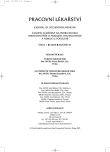-
Medical journals
- Career
The Method of Thermography Used for the Examination of Patients with Vessel Diseases from Vibrations
Authors: F. Hůzl 1; Z. Chudáček, jr. 2; L. Smolíková 3; J. Tvrzký 1
Authors‘ workplace: Zdravotní ústav se sídlem v Plzni, ředitel RNDr. Karel Maxa 1; Radiodiagnostické oddělení Fakultní nemocnice, LF UK Plzeň-Bory, vedoucí prim. MUDr. Zdeněk Chudáček, PhD. 2; Klinika pracovního lékařství Univerzity Karlovy v Praze, Lékařské fakulty v Plzni, přednostka as. MUDr. Vendulka Machartová 3
Published in: Pracov. Lék., 57, 2005, No. 1, s. 11-23.
Category: Original Papers
Overview
The authors examined 35 individuals, including 25 men with professional exposure to vibrations and 10 men of a control group in our study. They compared these diagnostic methods: finger plethysmography, thermometry and thermography. The latest clinical examination, especially the water cooling test undertaken during this examination, was considered the basic criterion for comparison.
The authors also carried on a complex medical examination including a professional history and an occupational clinical examination. The average age of all 35 examined individuals was 46.5 ± 12.1 years. There were eight grinders, nine polishers - -finishers, three polishers-grinders, two founders, one smith, one white bricklayer and one driver of lorries of the older type in the group of 25 exposed individuals. There were 10 workers in the control group, including six physicians, one nurse, two laboratory technicians and one technician.
The total average time of the exposure to vibrations was 18.12 ± 10.68 years in our sample. The daily average exposure to vibrations was 3.64 ± 1.38 hours. The majority of exposed workers have been already shifted to the other work. Comparing presented diagnostic methods in this small sample; the authors can state that thermography is a practical and useful method, which completes the examination of vessel diseases caused by vibrations and other diseases of peripheral vessels. However, it does not require a long cooling of the patient, which is required in other diagnostic methods according to the Methodical Instruction of the MoH.
There is a relatively good accordance (80 %) between a current clinical finding and undertaken thermography with the preparation of the patient according to Chucker.
The authors found a very good accordance between plethysmography and thermography. The current clinical finding shows a good accordance both compared with plethysmography and thermography. The discordance between thermometry and the current clinical finding can be explained by the fact that we used the method with warming and cooling patient’s hands according to Chucker before undertaking thermometry and also by the fact that recording of thermometric values from particular fingers was consequent, but not simultaneous. The disadvantage is that thermometry and thermography are time consuming methods. The authors plan to extend the sample of examined patients in the next study. They will also use thermography for prevention in the process of placing workers and apprentices to working positions with exposure to vibrations.Key words:
plethysmography, thermometry, thermography, water cooling test, clinical examination, comparison of methods, vessel
diseases from vibrations
Labels
Hygiene and epidemiology Hyperbaric medicine Occupational medicine
Article was published inOccupational Medicine

2005 Issue 1-
All articles in this issue
- The Long-term Excessive and One-sided Load of Extremities: Reported Occupational Diseases and Suspected Occupational Diseases in the Slovak Republic in 1996–2003
- The Method of Thermography Used for the Examination of Patients with Vessel Diseases from Vibrations
- Principles of Evaluation of Working Capacity in Refractive Errors and Eye Diseases
- Occupational Medicine
- Journal archive
- Current issue
- Online only
- About the journal
Most read in this issue- The Long-term Excessive and One-sided Load of Extremities: Reported Occupational Diseases and Suspected Occupational Diseases in the Slovak Republic in 1996–2003
- The Method of Thermography Used for the Examination of Patients with Vessel Diseases from Vibrations
- Principles of Evaluation of Working Capacity in Refractive Errors and Eye Diseases
Login#ADS_BOTTOM_SCRIPTS#Forgotten passwordEnter the email address that you registered with. We will send you instructions on how to set a new password.
- Career

